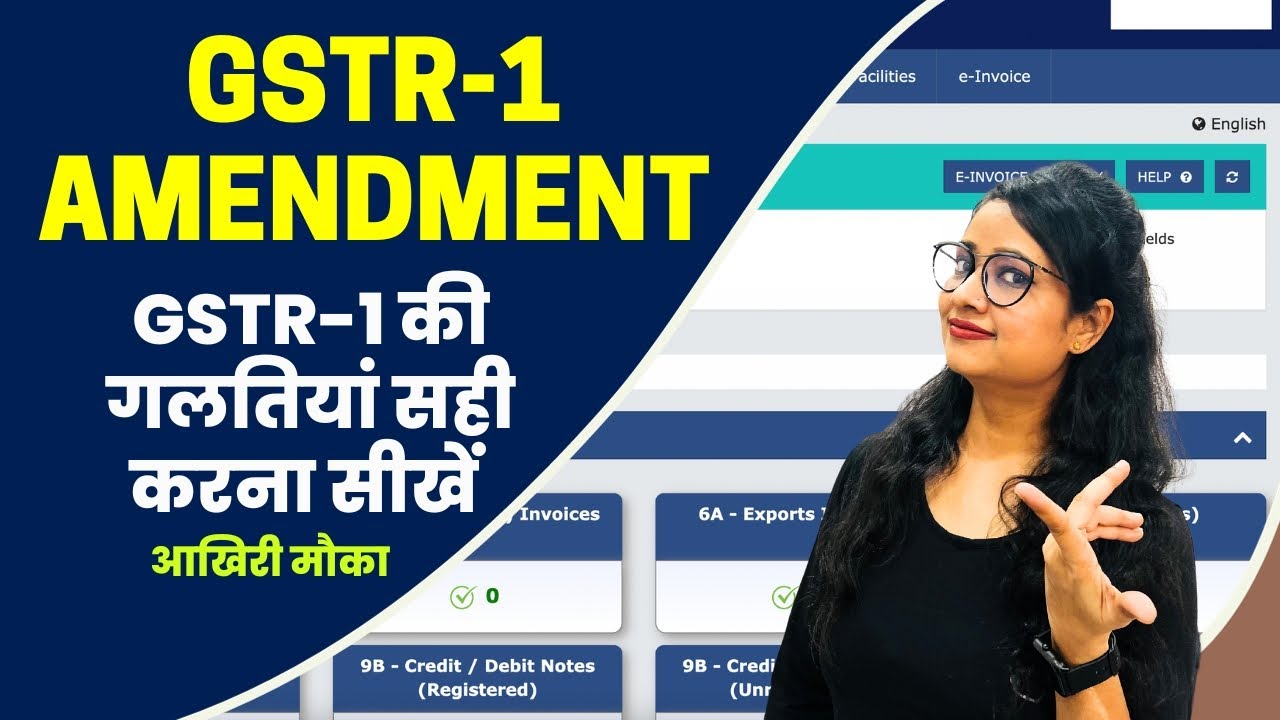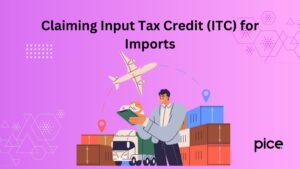How to Amend B2C to B2B in GSTR-1
- 13 Aug 24
- 15 mins

How to Amend B2C to B2B in GSTR-1
Key Takeaways
- Accurate Filings Ensure Compliance: Correcting B2C to B2B in GSTR-1 is key for GST adherence.
- Amendments Unlock ITC Benefits: Proper amendments allow buyers to claim crucial input tax credits.
- Avoids Penalties: Timely corrections prevent legal and financial repercussions.
- Optimizes Financial Health: Ensures accurate tax liabilities and financial efficiency.
- Boosts Credibility: Accuracy in amendments enhances business reputation.
- Facilitates Accurate Reconciliation: Essential for ITC claims and buyer-seller agreements.
In the realm of Goods and Services Tax (GST) in India, the accuracy of filed returns is paramount for both compliance and financial health of businesses. One common area requiring attention is the amendment of sales from Business-to-Consumer (B2C) to Business-to-Business (B2B) in GSTR-1 filings.
This adjustment is crucial for businesses that initially reported transactions as B2C sales by mistake and need to correct them to B2B to allow their clients to claim Input Tax Credit (ITC). This article delves into the intricacies of making such amendments effectively, ensuring compliance and optimizing tax liabilities.
Handle all your sales and purchase invoices in one place.
Pice’s all-in-one invoice management tool helps you track, send, and organize invoices from a single dashboard. Automatically share new invoices with customers, send timely payment reminders, and keep your collections under control—effortlessly.
Want early access? Fill out this form to get request a demo!
What is GSTR-1 in India?
All registered businesses in India must submit GSTR-1, a monthly or quarterly return, under the Goods and Services Tax (GST) system. It is essentially a document that details all outward supplies of goods and services made by a business. This includes sales to other businesses (B2B), sales to consumers (B2C), exports, and all other forms of supply.
The purpose of GSTR-1 is to declare the total sales of goods and services made by the registered taxpayer during the return period. It serves as the basis for the recipient to claim Input Tax Credit (ITC) and ensures that the government has a record of the taxpayer's sales transactions for the proper levy and collection of tax.
Businesses are required to file form GSTR-1 even if there is no activity or no sales during the return period, in which case a nil return must be filed. The annual turnover of the company determines the filing frequency; companies with a turnover above a certain threshold are required to file monthly, while those with a turnover below that threshold may choose to file quarterly.

A link exists between each GSTR-1 that a supplier files and the GSTR-2A that its recipients use to view the inputs they have purchased from various suppliers.
This linkage facilitates the seamless claiming of input tax credit by businesses and helps in the reconciliation of purchase records.
Filing GSTR-1 accurately is crucial for businesses, as it directly affects their tax liability and compliance rating. Errors or omissions can lead to legal penalties and affect the ability of recipients to claim ITC, thus emphasizing the importance of diligent filing practices.
B2C Sales
In GST terminology, B2C sales refer to transactions where goods or services are sold directly to consumers who are not registered under GST. These sales are typically reported in aggregate without details of the buyers.
B2B Sales
Contrastingly, B2B sales involve transactions between two GST-registered entities. These sales require detailed invoicing, including the GSTIN of the buyer, enabling the buyer to claim ITC.
The Need for Amendments

Mistakes in categorizing sales can arise due to various reasons, such as clerical errors or misunderstandings of the buyer's status at the time of sale. The GST framework accommodates corrections through changes in subsequent returns.
Common Reasons for Amendments
- Correction of Errors: Errors can occur due to various reasons, including incorrect GSTIN (Goods and Services Tax Identification Number) details, incorrect tax amounts, or misclassification of transactions (e.g., B2B instead of B2C sales or vice versa).Amendments ensure these errors can be rectified to reflect the true nature of transactions.
- Changes in Transaction Details: Sometimes, the terms of a transaction might change post-invoice issuance, such as alterations in the value of goods or services provided, changes in tax rates due to policy updates, or adjustments in the discounts offered. These changes necessitate amendments to the initially filed returns to ensure they accurately represent the final terms of the transactions.
- Prevention of Miscommunication and Disputes: Accurate GST filings are crucial for the smooth operation of the input tax credit system, as inaccuracies can lead to disputes between suppliers and recipients over tax credits. Amendments help prevent such conflicts by allowing corrections that align records between trading partners.
- Compliance and Legal Implications: Filing accurate returns is not only a matter of financial accuracy but also of legal compliance. Incorrect filings can lead to penalties, interest, and in severe cases, legal action. Amendments serve as a safeguard against potential compliance issues, allowing businesses to maintain a clean record and avoid legal repercussions.
- Optimization of Tax Liabilities: By rectifying errors or inaccuracies, businesses can ensure they are neither overpaying nor underpaying their taxes. This optimization of tax liabilities is essential for financial efficiency and can impact a company's bottom line.
- Enhanced Reputation: Timely and accurate amendments reflect positively on a business's commitment to compliance and transparency, enhancing its reputation among partners, regulatory bodies, and the public.
How to Amend B2C to B2B in GSTR-1
Amending a transaction from B2C (Business to Consumer) to B2B (Business to Business) in GSTR-1 is an important process for businesses that have initially reported a sale incorrectly.
This amendment allows businesses to rectify the error, enabling their buyers to claim the input tax credit (ITC), which is not available in B2C transactions. Here's the step-by-step guide on how to make such an amendment to the GSTR-1 return:
Step 1: Access the GST Portal
First, you need to access the official GST portal (gst.gov.in). Log in to your account using your credentials (GSTIN, username, and password).
Step 2: Navigate to GSTR-1 Form
After logging in, go to the 'Services' menu, select 'Returns Dashboard', and then choose the financial year and return filing of details period for which you need to make the amendment. Click on the 'Prepare Online' option under the GSTR-1 page.
Step 3: Select the Amendment Section
In the GSTR-1 dashboard, look for a section dedicated to amendments. This could be labeled as "Amendments to B2B invoices" or a similar term, depending on the portal's current layout and updates.
Step 4: Amend B2C to B2B Transaction
Within the amendment section, you will need to add the details of the valid invoice that was incorrectly reported as B2C. You will have to input the correct B2B invoice details, including:
- The original invoice number and date
- The corrected GSTIN of the buyer
- The total transaction value
- The taxable value and tax amounts (CGST, SGST/UTGST, IGST, and Cess, if applicable)
Ensure that you enter the details accurately to avoid further discrepancies.
Step 5: Review and Submit
After entering all necessary details for the amendment, review the information thoroughly to ensure accuracy. Any mistakes in the amendment can lead to further complications and may require additional changes. Once you are satisfied that the details are correct, submit the amended GSTR-1.
Additional Tips:
- Documentation: Keep records of all communications and documents that support the need for amendment, such as email exchanges with the buyer or revised purchase orders.
- Timeliness: Amend the errors as soon as they are discovered to avoid potential complications with tax liabilities and ITC claims for both parties.
- Consultation: If you are unsure about any part of the process, consider consulting with a GST practitioner or a tax professional to ensure compliance and accuracy.
By following these steps, businesses can amend B2C transactions to B2B in their GSTR-1 filings, thus correcting their tax filings and enabling their buyers to claim the appropriate ITC. This process not only helps in maintaining accurate tax records but also supports compliance with GST regulations.
Implications of the Amendment

B2C Amendments (Business to Consumer) to B2B (Business to Business) in GSTR-1 has significant implications for both the seller and the buyer.
These changes are not just corrections in paperwork; they carry financial and compliance impacts that affect the tax liabilities and input tax credit (ITC) entitlements of both parties involved.
Here's how the amendment impacts the seller and the buyer:
For the Seller
- Tax Liability Adjustments: By converting a B2C sale to a B2B sale, the seller might need to adjust the tax liability accordingly. Since B2B sales are reported with detailed GSTIN information, any error in classification that is later corrected could affect the seller's tax calculations and payments.
- Compliance and Record-Keeping: The amendment process requires the seller to maintain accurate records and documentation to support the changes made. This includes keeping track of invoice level changes, communication with buyers, and documentation of the original error. Proper record-keeping is essential for compliance and to facilitate potential audits by tax authorities.
- Reputation and Trust: Efficiently managing and promptly correcting mistakes through amendments can enhance the seller's reputation with buyers. Demonstrating a commitment to accuracy and compliance builds trust in business relationships.
- Potential Penalties and Interest: If amendments are not made in a timely manner or if the original mistake led to underreported tax liabilities, the seller could be subject to penalties and interest. Making changes as soon as errors are identified helps minimize these risks.
For the Buyer
- Entitlement to Input Tax Credit (ITC): The most significant impact of the amendment on the buyer is the ability to claim ITC. B2C sales do not allow the buyer to claim ITC, but once the sale is correctly classified as B2B, the buyer can claim the tax credit. This can lead to significant cost savings and improve cash flows for the buyer.
- Compliance and Reconciliation: For the buyer, the reform facilitates the reconciliation of their purchases with the invoices reported by their suppliers in GSTR-1. Accurate matching is crucial for claiming ITC, and amendments ensure that the buyer's records align with the tax authorities' records.
- Record-Keeping: Just like sellers, buyers must also maintain accurate records of transactions, including communications regarding amendments. This documentation is essential for validating ITC claims during audits.
- Financial Planning: The ability to claim ITC after an amendment can impact the buyer's financial planning and tax liabilities. Receiving credit for previously unclaimed ITC can lead to better financial outcomes and budgeting accuracy.
Avoiding Common Mistakes
To minimize the need for amendments:
- Verify the GST registration status of buyers before invoicing.
- Implement a robust review process for GST filings.
- Legal and Compliance Considerations
When amending transactions from B2C (Business to Consumer) to B2B (Business to Business) in GSTR-1 filings, it's crucial to consider the legal and compliance aspects within the GST framework.
These considerations are designed to ensure that changes are made accurately, timely, and in accordance with the GST laws and regulations, minimizing the risk of legal repercussions and ensuring smooth tax operations. Here are some key legal and compliance considerations:
Legal Framework
- GST Act and Rules: The GST Act and the rules framed thereunder govern the procedures for amendments in GSTR-1. It's essential to be familiar with these legal provisions to understand the rights and obligations concerning amendments.
- Time Limits for Amendments: The GST laws specify time limits within which amendments can be made. Typically, amendments for a particular financial year can be made up until the due date of filing the return for September of the following financial year or the actual date of filing the annual return, whichever is earlier.
- Documentation and Record-Keeping: Legal provisions require businesses to maintain accurate records of all transactions, including any updates. These records must be kept for a specified period (generally six years) and be readily available for inspection by tax authorities.
Compliance Aspects
- Accuracy of Information: Ensuring the accuracy of the amended details is critical. This includes correct GSTINs, invoice values, tax amounts, and other pertinent information. Errors in the amendment can lead to compliance issues and may necessitate further changes.
- Reconciliation: The amendments in invoices should be reflected in both the seller's and buyer's records for reconciliation purposes. Discrepancies can lead to questions from tax authorities and difficulties in claiming input tax credits.
- Tax Liability Adjustments: Sellers need to be mindful of the impact of amendments on their tax liabilities. Correcting a B2C sale to a B2B sale may alter the tax amount payable or refundable. It's important to adjust these figures in subsequent tax payments or claims.
- Notification to Buyers: In case of amendments, sellers should inform their buyers promptly. This is crucial for the buyers to claim the input tax credit and reconcile their own records.

Audit and Inspection: Businesses should be prepared for audits or inspections by tax authorities. Accurate amendments, along with proper documentation, facilitate a smooth audit process.
- Penalties and Interest: Non-compliance with the amendment procedures, including missing deadlines or providing inaccurate information, can result in penalties and interest. Understanding the consequences of non-compliance is crucial for businesses to take timely and correct actions.
Best Practices
- Regular Review and Audit: Businesses should regularly review their GST filings and audit their transaction records to identify any discrepancies that may require amendments.
- GST Compliance Software: Utilizing GST compliance software can help in accurately managing transactions, including the amendment process.
- Professional Advice: Consulting with GST experts or tax professionals can provide valuable insights into the legal and compliance aspects, ensuring that amendments are handled correctly.
Conclusion
GSTR-1 filings must include a process for converting B2C to B2B transactions in order to ensure GST compliance and optimize financial health in India's tax environment. The rectification of errors that were present in the initial filings through these amendments serves to facilitate the proper flow of input tax credits and maintain the integrity of the GST framework.
Precise amendments provide advantages to businesses in the form of compliance-enhancing reputation, legal penalty avoidance, and tax liability optimization. Transparency and efficiency in tax operations can only be achieved through the implementation of best practices and compliance with legal requirements regarding GST filings.
In order to cultivate confidence and dependability in commercial transactions within the Indian market, the proactive administration of GST amendments is ultimately critical.
💡Get started with PICE today and streamline your GST payments and export invoicing process. Click here to sign up and take the first step towards hassle-free GST management.



















